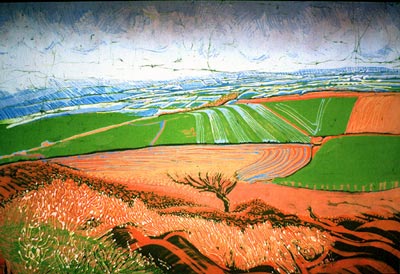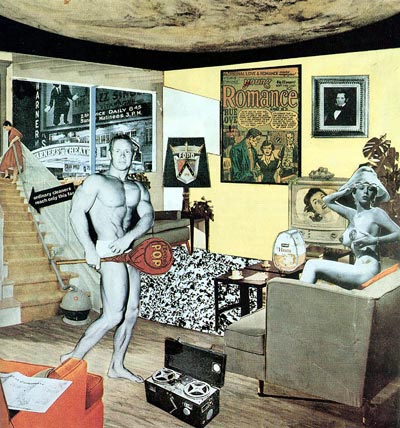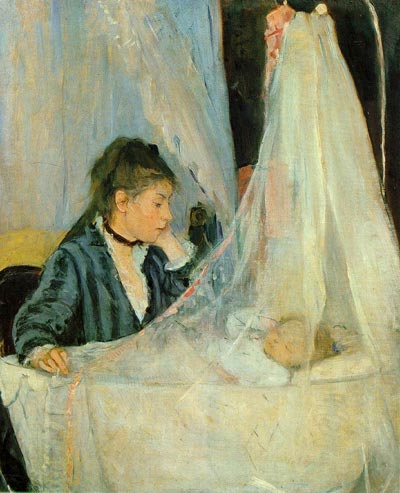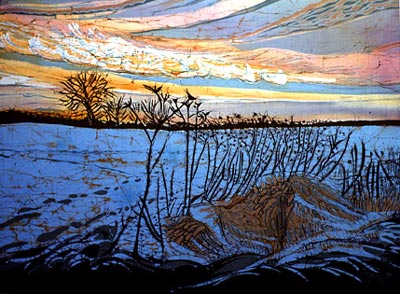Welcome to a brand new series of articles on the Artworks blog. It’s called quite simply ‘Take five with…‘ – and it aims to be an engaging & informal introduction to each one of our Artworks artists. Without further ado, let’s ‘take five‘ with batik artist & painter Helen Dougall…
Firstly, Helen tells us a little about what inspires her as an artist and how she makes her batik paintings.
I have always been interested in landscape in all its diversity, after my childhood in Wales and now living in Suffolk, but also the visible effects that man has made, negatively and positively, on the landscape. Expressing “a sense of place” and my reaction to it is important to me. I paint and draw directly from observation, in an effort to capture the complete essence of landscape.
 |
| © Helen Dougall, Oil Seed Rape Field with Trees, gouache on paper |
My drawings and paintings, mainly in gouache or aquarelle pastel are always done on the spot. These media have an immediacy which enables me to express my interest in space and colour. These ideas also have a particular affinity with the craft of batik, in the way molten wax can be painted or drawn across dyed fabric to produce textural effects.
To make a batik painting, selected areas of fabric are blocked out with molten wax and then the fabric is dyed. The waxed areas resist the dye, while un-waxed areas absorb the dye. The process of waxing and dyeing is repeated by waxing or blocking out areas on the dyed fabric after it has dried, then dyeing it a different colour.
Because dyes are transparent, the second colour is changed by the first colour e.g. a blue over yellow will produce green. Some of my batiks are immersed up to seven or eight times, usually starting with the lightest colour and progressing through medium tones, finishing with the darkest colours.
 |
| © Helen Dougall, Sand and Sea, batik wall-hanging |
A particular effect of successive dyeing is the harmonious, layered combination of colours, i.e. apart from the first colour all the following ones are combinations of all the preceding colours. Another effect is the emergence of fine hair-lines within the design, caused by the wax cracking in the dye bath, or it is deliberately “crunched” to produce a subtle “crackle” effect.
Sometimes the dyes are selectively painted on rather than immersing the whole fabric in the dye bath. After the final dyeing the wax is later removed from the fabric by ironing & blotting between sheets of newsprint to reveal the final design. The piece is then dry-cleaned, washed, dried and mounted on a frame much like a canvas.
An awareness and sense of colour is obviously very important to you as an artist. What is your favourite colour & why?
A bluey-greyey-green, the colour of the sea on the west Wales coast. The Cardiganshire and Pembrokeshire coast are very inspiring locations in addition to the landscape of East Anglia. I am particularly interested in the effect of sunlight across stubble fields, or seascapes with wet, shiny undulating beaches or multicoloured shingle.
 |
| © Helen Dougall, Beach Watermarks, batik wall-hanging |
So, for someone completely new to your art, how would describe it in just a few simple words?
Subtle, colourful, textural, feeling, atmospheric, and ‘landscape’ is a word I use quite a lot in reference to my work.
Why do you make art?
It sounds corny, but I need to be creative. So, how do you generate or develop the ideas for your work? Lots of drawing from observation, taking photographs and improvising, with different visual ideas.
Could you describe your studio space/set-up.
My studio is a converted farm building, a cart shed adjoining an old stable and barn, it’s long and low and it faces south, so we put in a north-facing roof-light, and it looks out onto a secluded garden.
Your studio sounds wonderful! What’s a typical working day for you as an artist?
The morning is mostly devoted to domestic chores, paperwork and e-mails, sometimes dog-walking and looking out for places that are interesting to draw. Afternoon and sometimes evening, is when I retreat to my studio, or if the weather is good, I go out with my easel and paints. If I’m working in batik, after spending a long time painting and drawing wax on cloth, I soak the whole piece in dye. While it is drying, and before I can continue with it, I might go and hoe a row of carrots! What time in the day are you at your most creative, do you think? Around mid afternoon.
And, what do you listen to while creating?
I listen to the radio and classical or jazz music.
Would you care to share what’s in your current sketchbook?
Drawings of raised furrows across a field where I think onions have been planted.
 |
| © Helen Dougall, Preseli Fields, batik wall-hanging |
Which living artist do you most admire and why?
Howard Hodgkin. Fantastic colour and being able to describe a feeling or place in abstract terms with such an economy of incredibly sensitive brushstrokes.
So, that leads nicely to the question, which famous artwork would you most like to own, if money & space was not an issue?
One of Howard Hodgkin’s paintings, possibly ‘Blue Remembered Hills’.
 |
| Howard Hodgkin, Blue Remembered Hills, oil on wood 2002-03 |
Could you name one work of art (contemporary or historical) that you don’t like – and why?
Richard Hamilton’s ‘Just what is it that makes today’s homes so different, so appealing?‘. It describes an age I was trying to move away from, it makes me cringe – so I suppose it was effective in its intentions!
 |
| Richard Hamilton, Just what is it that makes today’s homes so different, so appealing? 1956 |
Share something unusual you’ve learnt from looking at the work of other artists.
Nostalgia, such as looking at Eric Ravilious’s watercolour, ‘An Attic Bedroom‘, the camp bed in a bare-boarded, cluttered room; it reminds me of childhood summer holidays.
 |
| Eric Ravilious, An Attic Bedroom, watercolour on paper, 1932-34 |
Which artist (dead or living) would you fancifully like to invite to dinner and what question/s would you ask them?
Berthe Morisot. What was it like being almost the only woman painter (of note), surrounded by so many men painters at the end of the nineteenth century in France? Also, what was her attitude to motherhood after her painting of ‘The Cradle‘ ?
 |
| Berthe Morisot, Le Berceau (The Cradle), oil on canvas, 1872 |
That’s a very interesting point regarding female artists in society. What do you think is the role of an artist in today’s society?
To reflect good and bad things; I tend to go for the aesthetic.
Students of art might be reading this with great interest, so what single piece of advice would you give them to make it as an artist?
Keep following your hunches and learn many hand-skills, drawing, painting, printmaking, working in 3D, as many techniques as possible because art schools have tended to offer fewer in recent years.
 |
| © Helen Dougall, Snow Field, batik wall-hanging |
And lastly, what is your personal motto (if you have one)?
Get something done each day, however insignificant.
Thank you Helen, for a small glimpse into your creative world, and that’s a very good note to end on! I am sure our readers will be inspired. There is clearly a lot of time & skill involved in Helen’s incredibly detailed batik paintings and she explains the many stages of creating one her batiks, ‘The Snow Field‘ (shown above), on her own website.
Helen also runs short courses in batik techniques; further details can also be found on Helen Dougall’s website.
Helen Dougall studied fine art at Chelsea School of Art and then trained as an art teacher. She taught in London and then Suffolk for many years, pursuing her own art full-time from 1997. Helen is a member of the Batik Guild, the Suffolk Craft Society and Artworks.